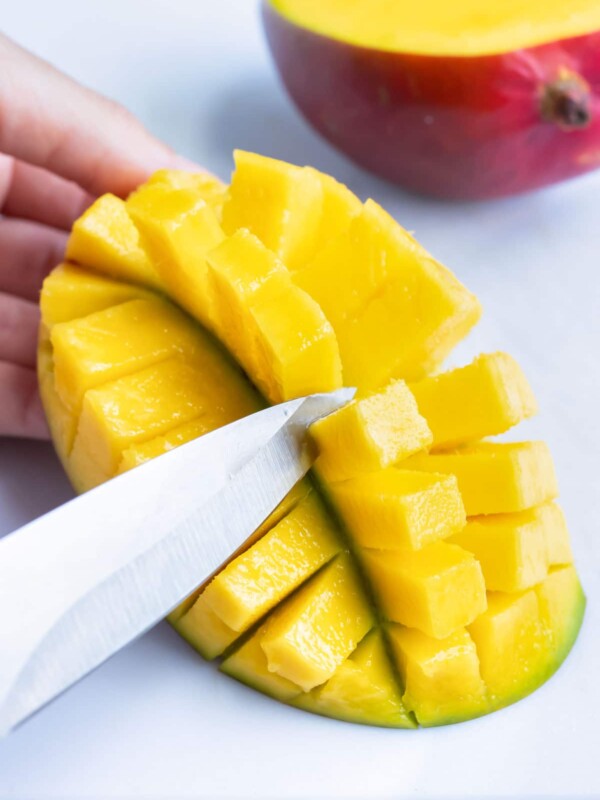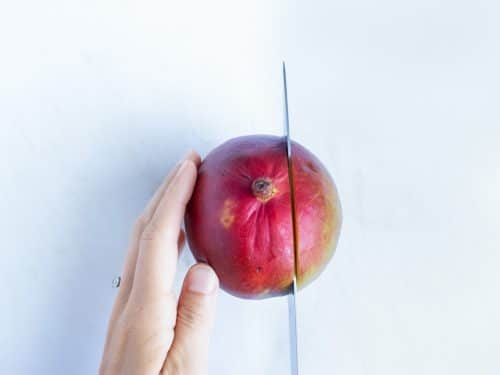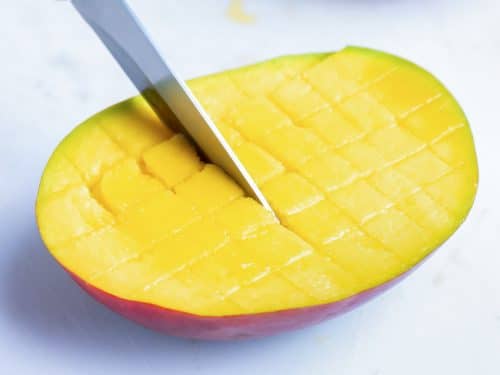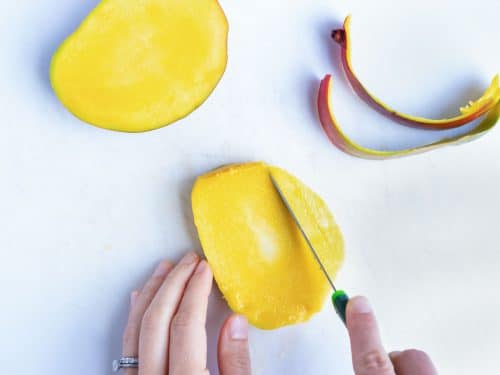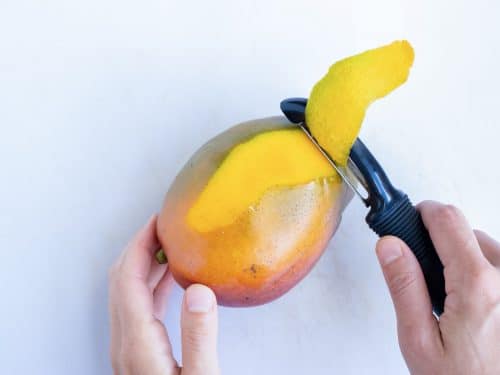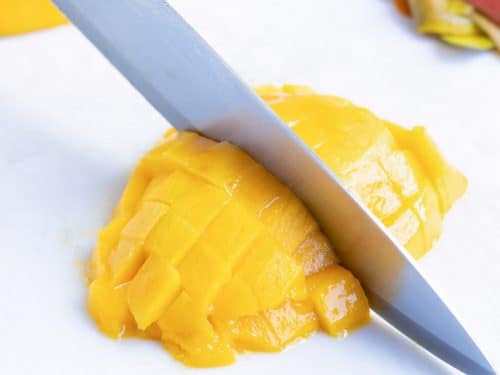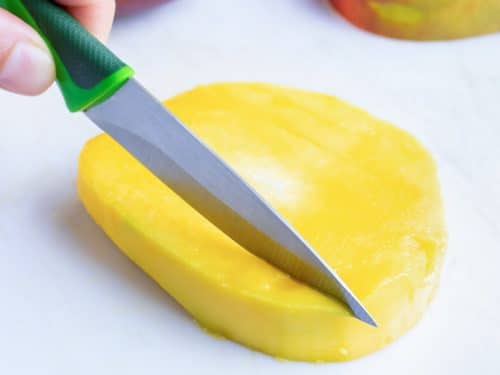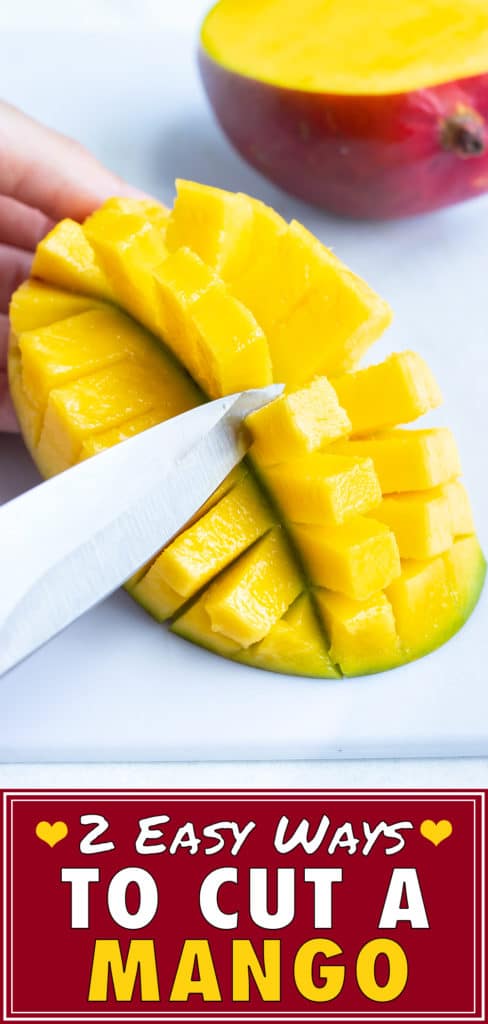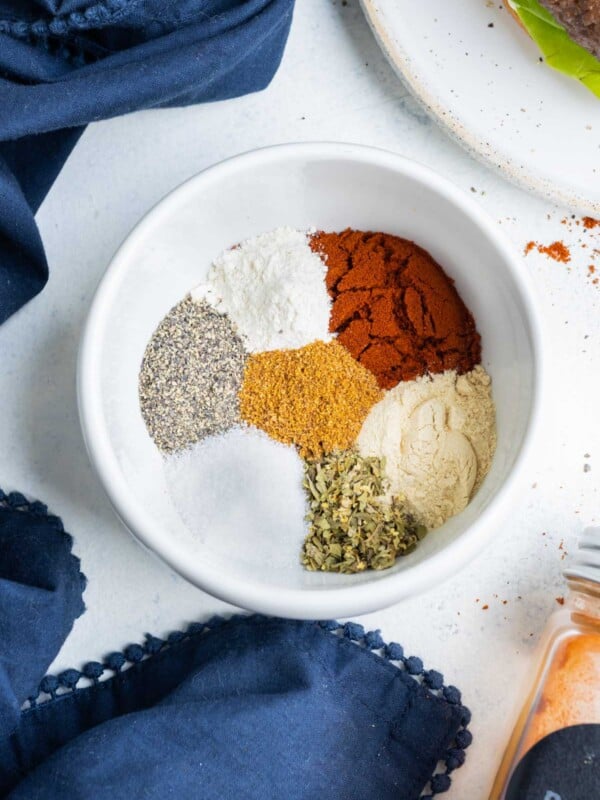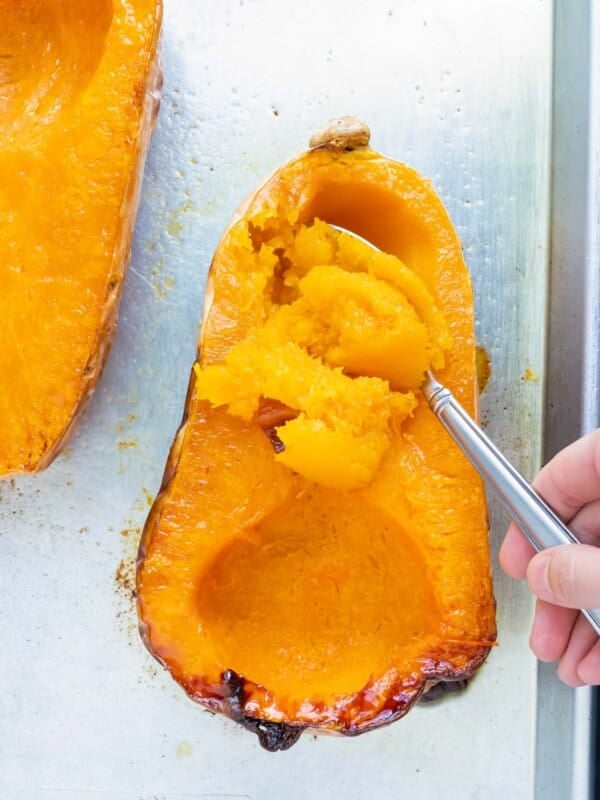2 Easy Ways to Cut a Mango
I have been OBSESSED with making all things mango lately. (Yes I’m talking about you, Mango Avocado Salsa and Mango Coconut Rice!)
With this love also comes the need to know how to cut into these tricky tropical fruits quickly and efficiently.
When it comes to cutting a mango, there’s not just one BEST way to do it. In fact, there are 2 very easy ways to cut into this delicious tropical fruit.
First, by strategically slicing off the thicker cheeks of fruit alongside the pit. (Don’t worry about these weird words, we’ll go over the anatomy of a mango below!)
Or, by first peeling the skin with a vegetable peeler and then slicing away.
Both methods will give you a mango that is peeled, pit removed, and flesh that can easily be sliced or diced to use in your favorite recipes!
Cutting a Mango – Instructional Video
Table of Contents
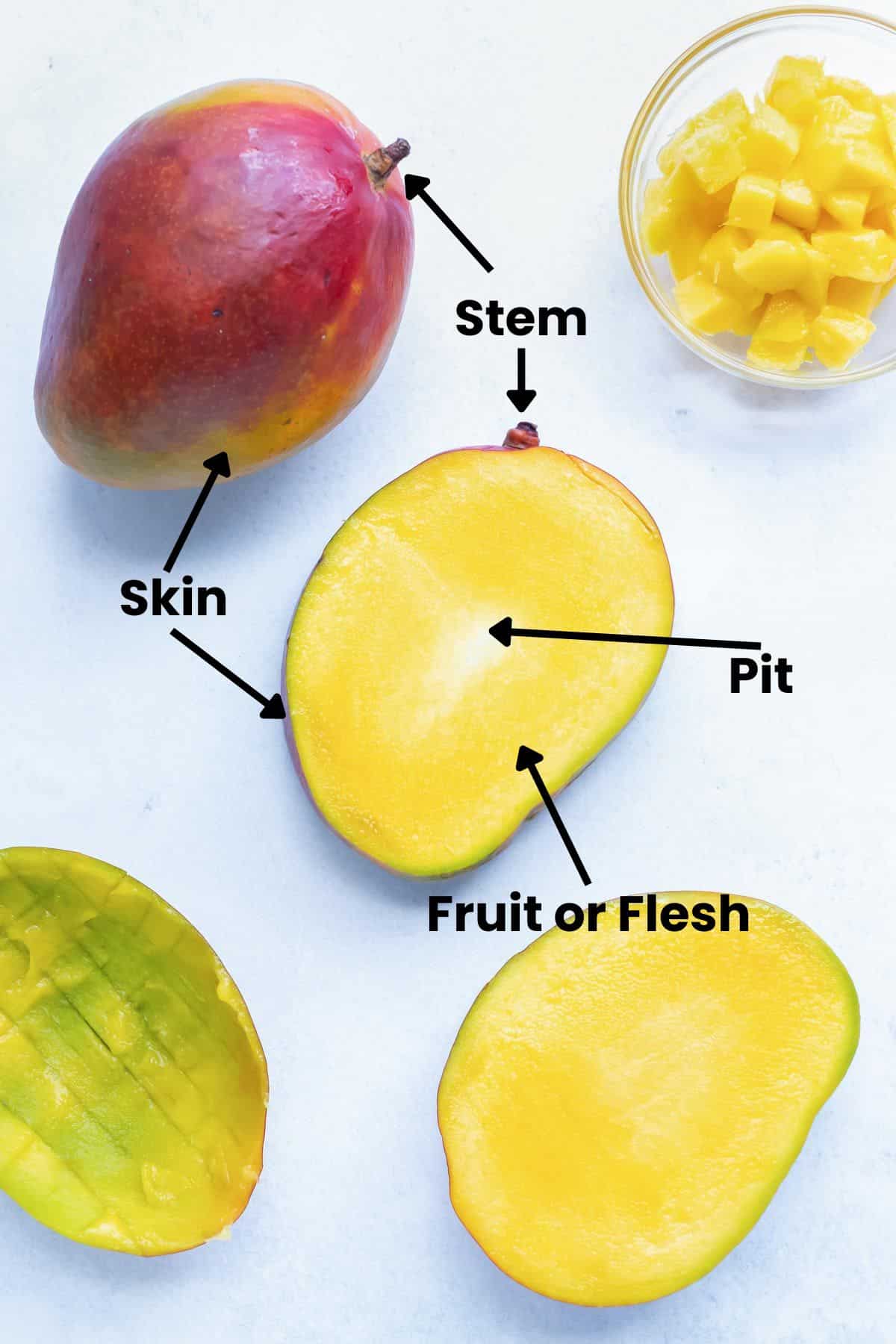
What are Mangoes?
Mangoes are a stone fruit, like peaches, plums, and nectarines. They are grown on trees and typically found in the tropical regions of South Asia, with India and China being the top producers.
Mangoes are made up of a thin, inedible skin (or peel) with a juicy pulp (or flesh) and a thin, subtly oblong pit running through the very center of the fruit. << See images above!
They are sweet enough to be eaten on their own as a dessert or snack or used in recipes such as Mango Salsa or Sticky Mango Rice.
How to Cut a Mango with a Knife
1. Slice the Cheeks
Place the mango on a cutting board with the stem facing up. Insert a sharp knife about ¼-inch to the right of the midline. Starting from the top of the fruit, cut all of the way down to the bottom. Repeat this process with the left side of the mango. You should have 3 slices of mango at this point (2 cheeks and 1 midsection with the pit.)
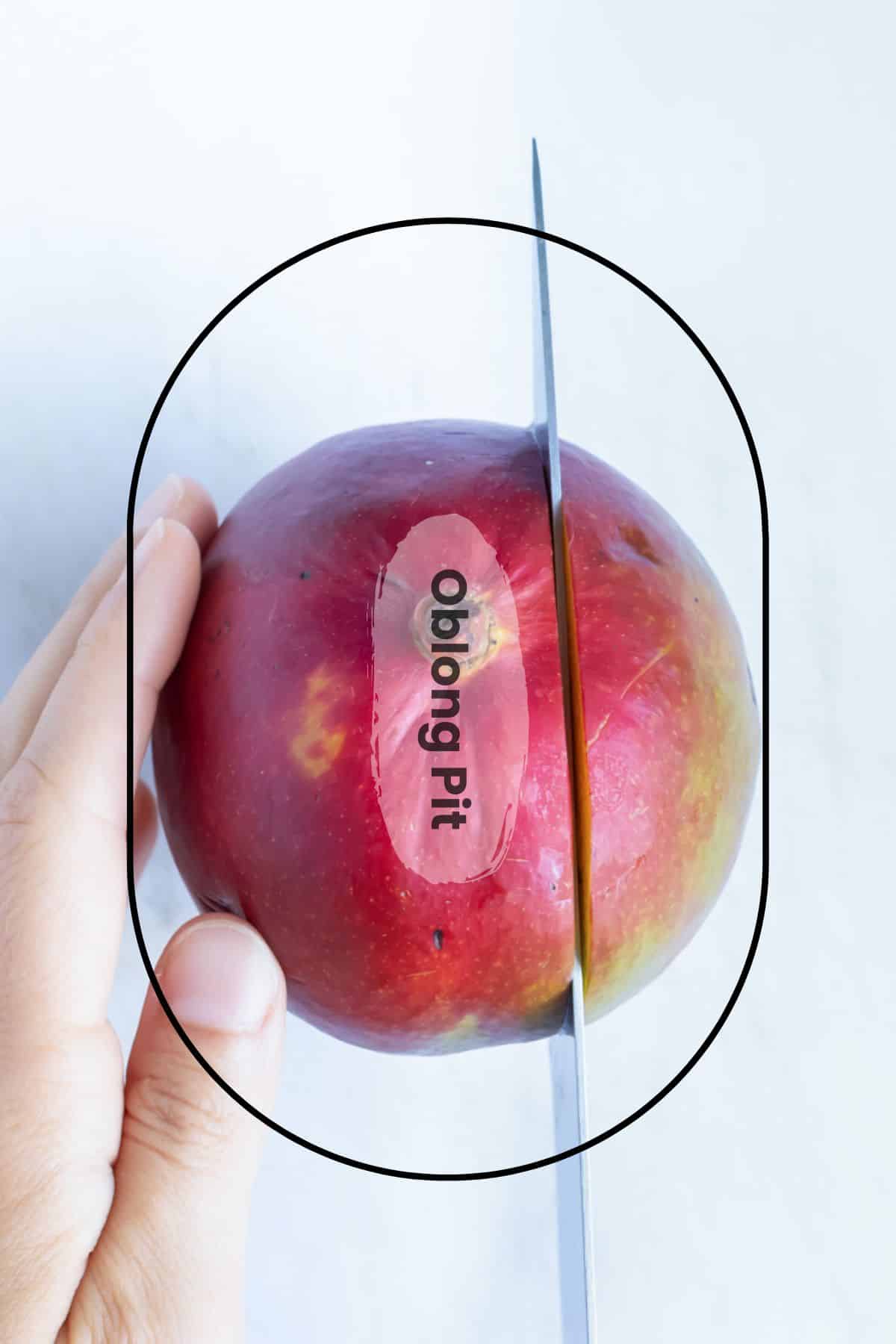
2. Dice the Flesh
Using a small paring knife, hold the mango in your non-dominant hand and make vertical incisions into the flesh of the mango. Pay careful attention not to cut all of the way through into the skin. Turn the mango 90 degrees and make vertical cuts that intersect the previous ones in a crosswise fashion. Repeat this step with the other mango cheek.
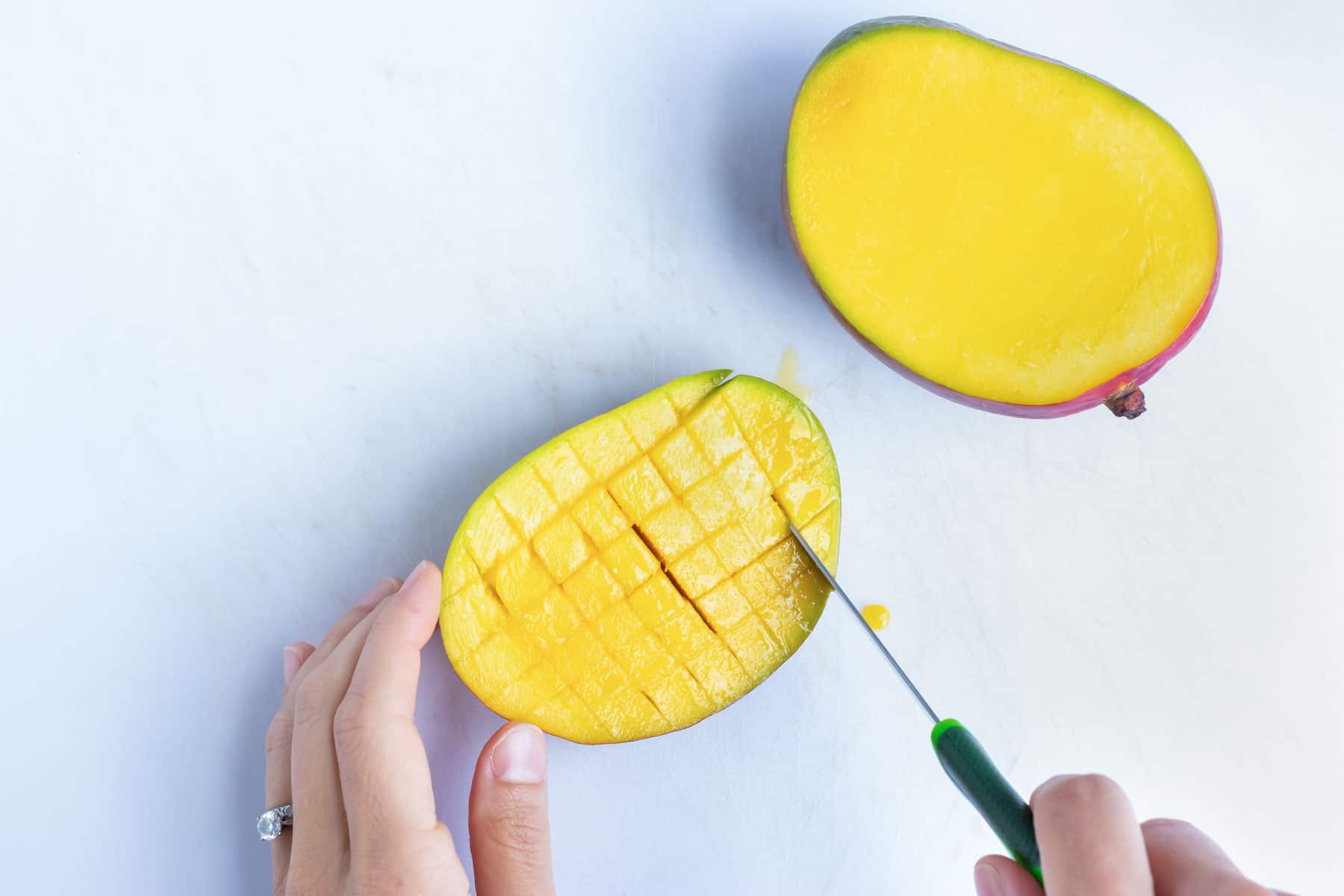
3. Cut, Peel, or Spoon the Flesh
You can remove the mango pieces by either using a paring knife, your thumb, or a spoon. Place your tool of choice where the flesh meets the skin and cut/push/scoop it off.
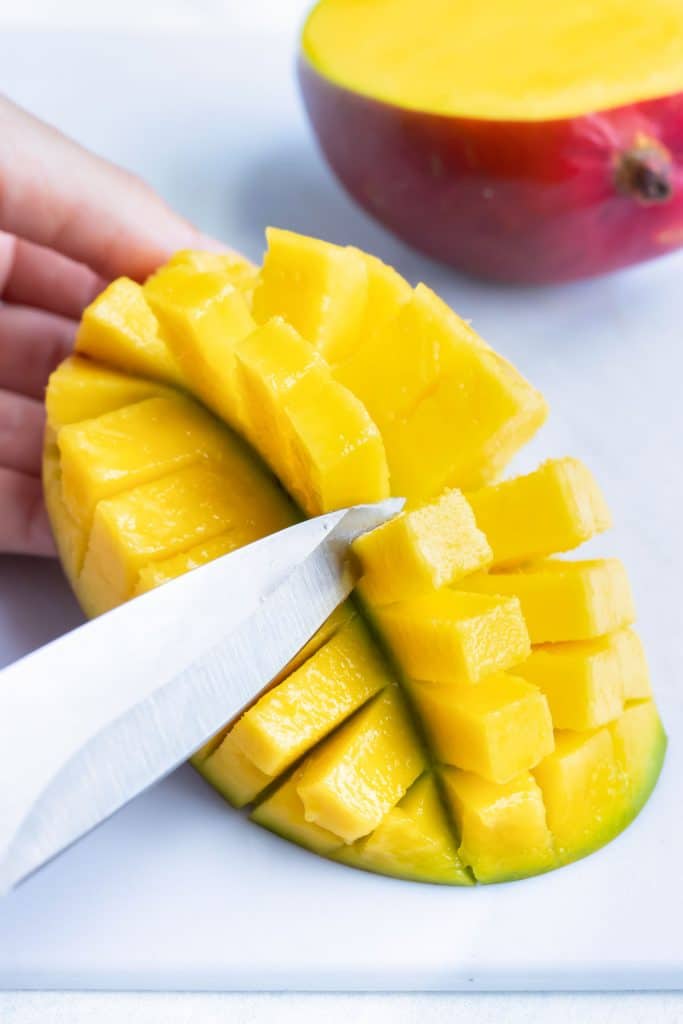
4. Remove the Extra Mango
There may still be some edible mango left around the pit. To get to this, place your paring knife into the skin of the midsection piece and carefully cut between the flesh and the skin to remove it. Cut and remove any additional mango flesh until the pit is all that’s left.
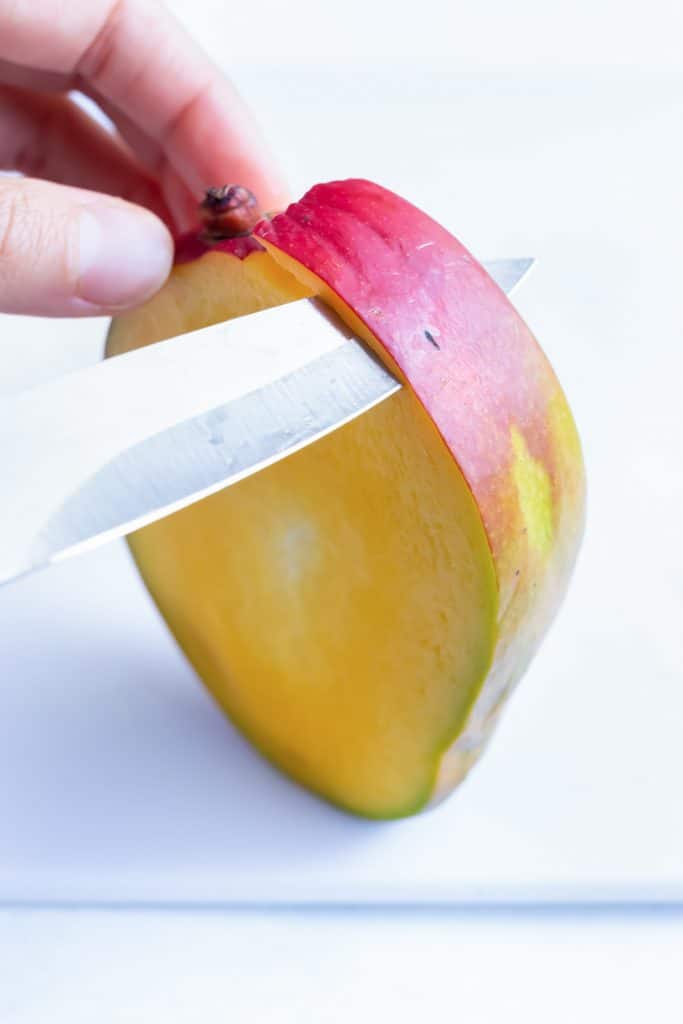
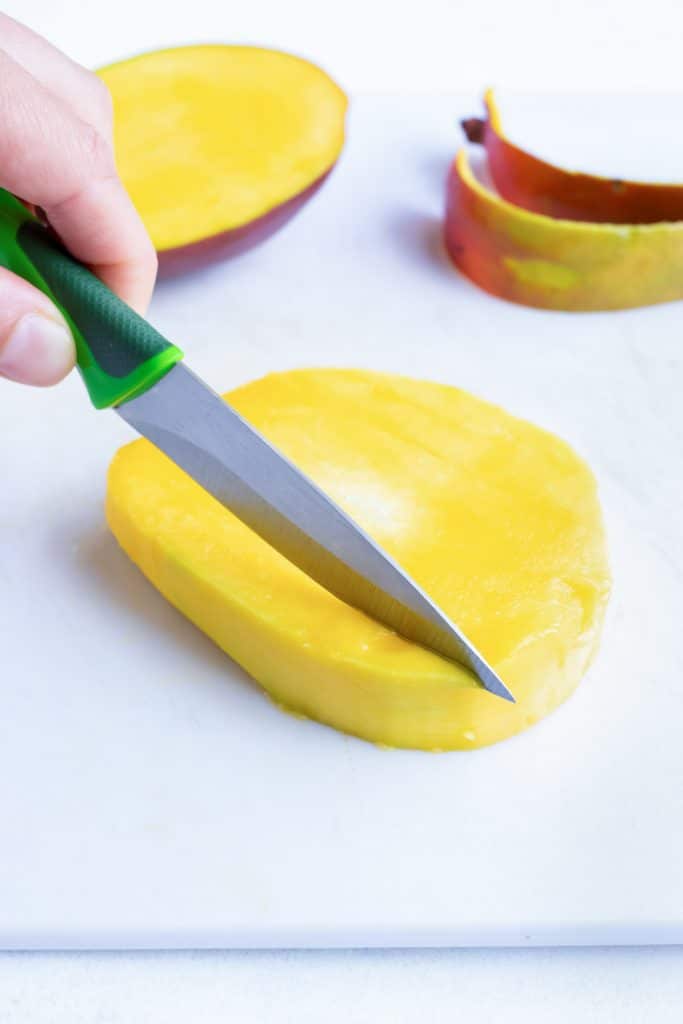
Cutting a Mango Using a Vegetable Peeler
1. Peel the Skin
Using a vegetable peeler, remove all of the skin from the mango.
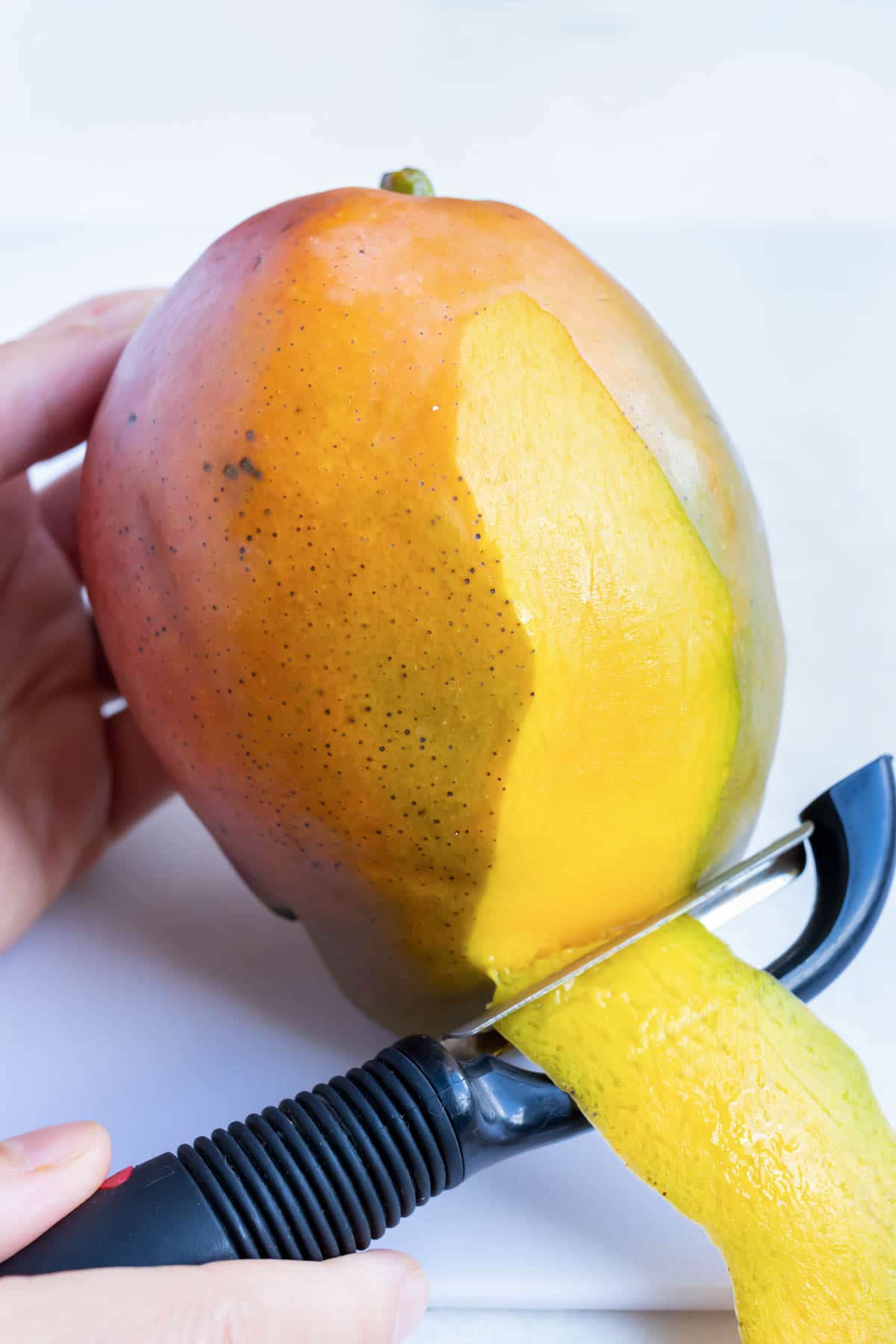
2. Cut the Cheeks
With the stem side facing up, remove the right and left cheeks from the mango with a small paring knife.
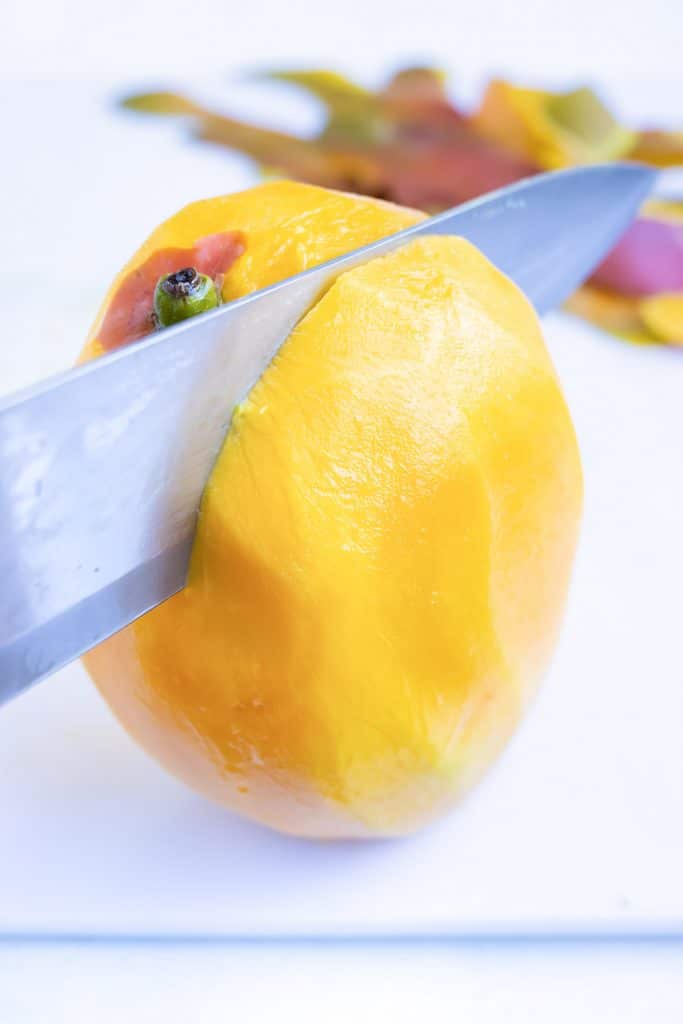
3. Dice the Fruit
Place the mango cheeks flat-side down on a cutting board and chop to your desired size.
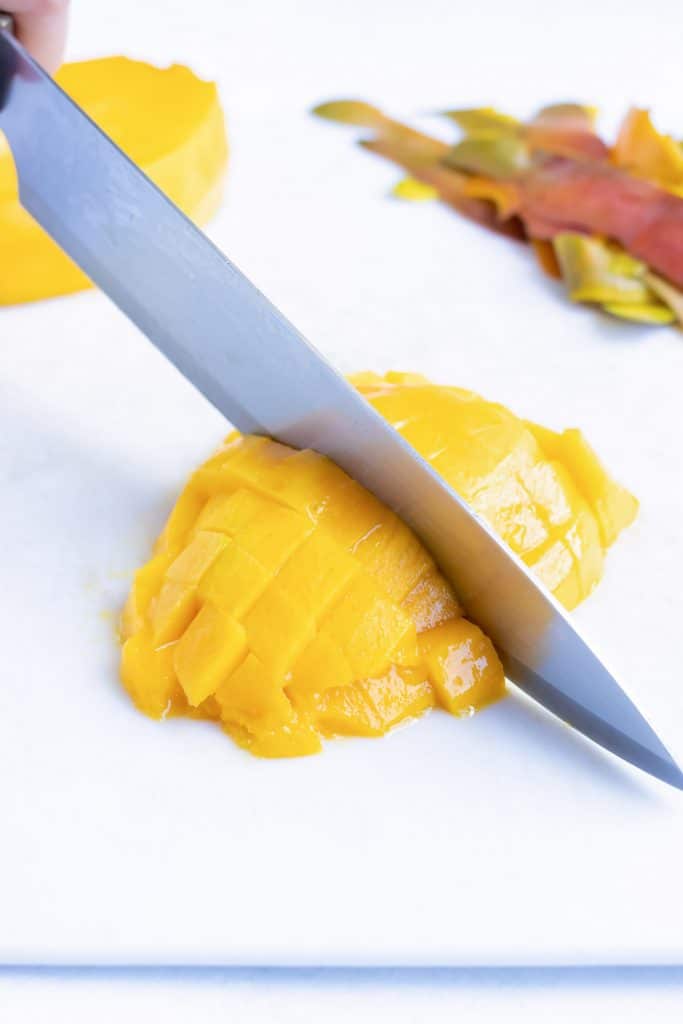
4. Clean the Pit
Remove any of the remaining edible flesh around the pit and dice.
Selecting a Ripe Mango
While they can normally be found year-round in the United States, May through August is mango season, with June-July being their peak production time.
Much like avocados and peaches, selecting a ripe mango depends primarily on how they feel, and not so much on their appearance or color.
To determine if a mango is ripe, apply firm but gentle pressure to the fruit. If it gives slightly when squeezed, it is ripe and ready to eat.
A mango will also emit a slightly sweet and fragrant aroma from its stem end as it becomes more ripe.
Mangoes will ripen naturally on their own if kept at room temperature for a few days.
You can also place the mango in a sealed paper bag for 2 days if you would like to speed up the process slightly.
Once they are ripened, you can place the fruit in the refrigerator for a few days.
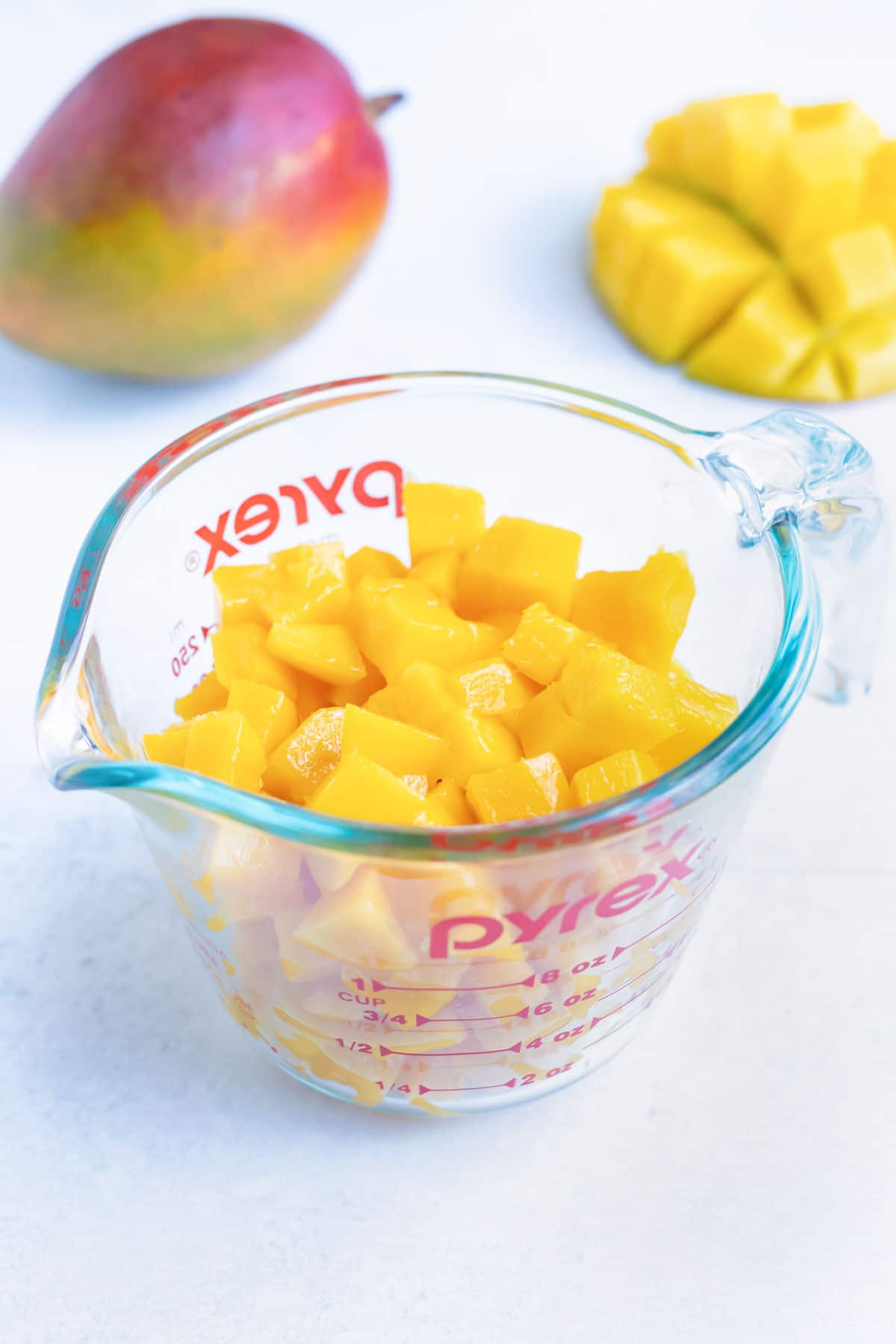
Health Benefits
Mangoes are not only delicious, but they’re healthy for you! Containing many nutrients and antioxidants, they can help boost immunity, support heart health, and aid in digestion.
The nutrition facts for one cup of mango are:
- Calories: 99
- Fat: .6 grams
- Carbs: 24.7 grams
- Fiber: 2.6 grams
- Protein: 1.4 grams
Mangoes also pack in healthy vitamins and minerals. Just one cup of the fruit contains 67% of the daily recommended amount of Vitamin C. They also are a good source of Vitamins B6, A, E, B5, and K, as well as copper and folate.
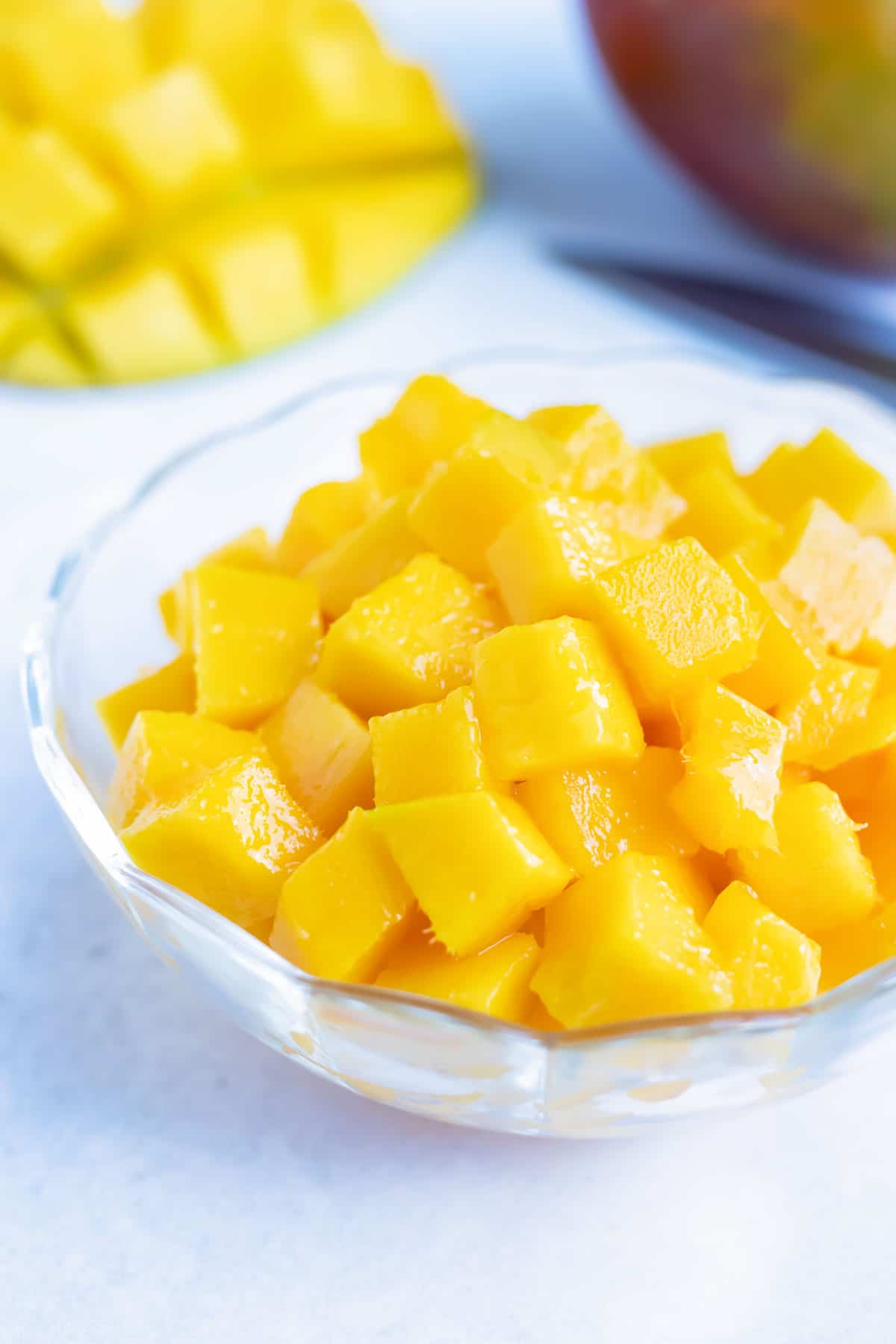
FAQs
Store a mango by placing a freshly cut, diced, or sliced one in an airtight container and store in the refrigerator for up to 2-3 days.
To freeze a mango, place cut fruit in a single layer on a baking sheet, cover with plastic wrap, and freeze for at least 4 or up to 24 hours. Place frozen mango pieces in a freezer-safe Ziploc bag and store them in the freezer for up to a year.
No, it is not recommended to eat mango skin. While it is not truly poisonous, it does contain urushiol which is the oil that causes poison ivy rash.
Yes, mangos are healthy. While mangoes are extremely low in fat, they are full of carbohydrates, fiber, natural sugar, and potassium. Mango is a healthy dessert option for those not on a particular diet. People on a low-carb, keto, or diabetic diet may want to avoid mangoes due to their high carbohydrate and sugar content.
One medium-sized mango will yield 1 ¼ – 1 ½ cups of fruit.
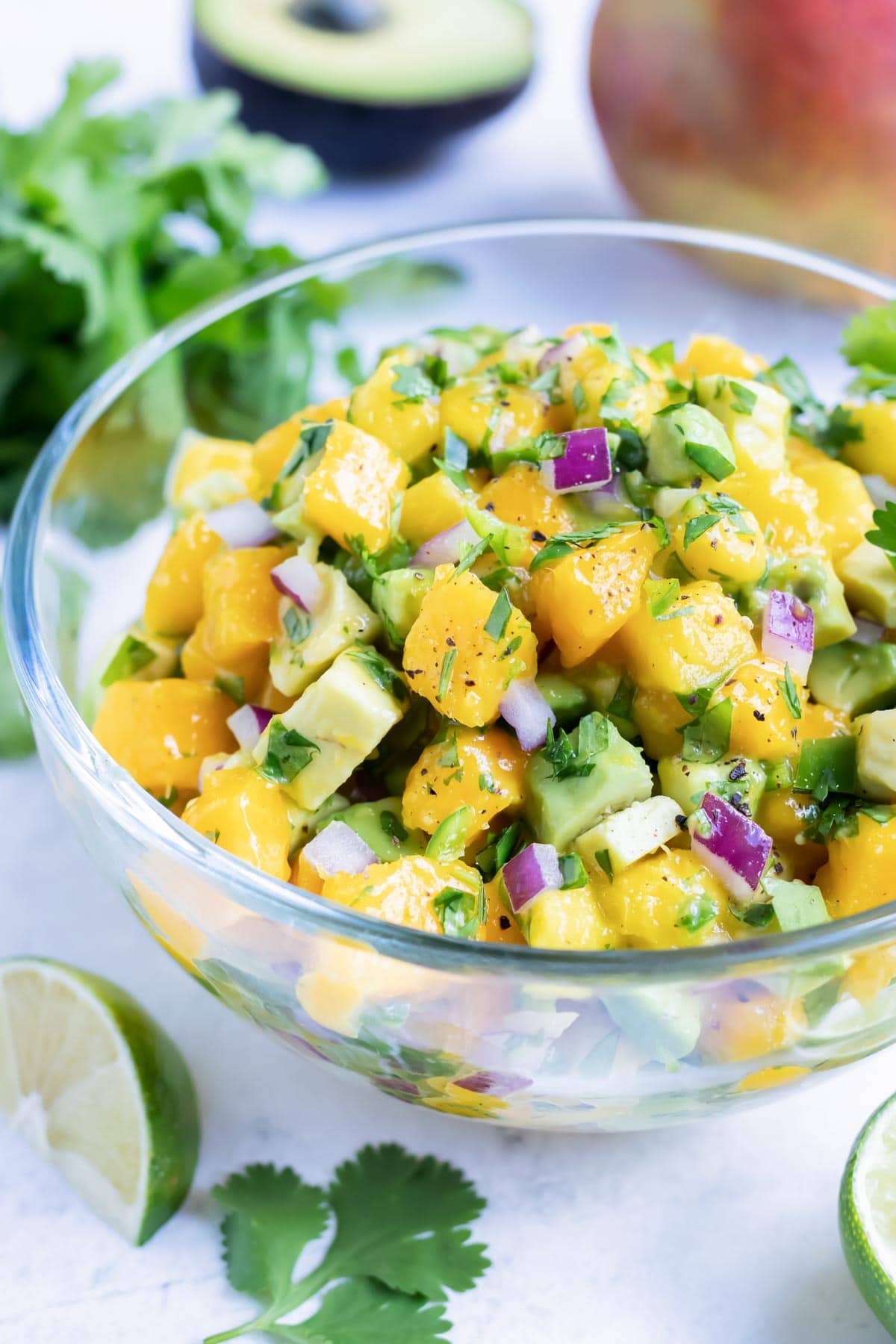
Mango Recipes
While this delightful fruit makes a delicious snack or dessert on its own, here are a few ways you can use it in some healthy recipes:
- Mango Avocado Salsa
- Pineapple Spinach Green Smoothie
- Blackened Mahi Mahi with Mango Salsa
- Mango Lassi
Tap stars to rate!
How to Cut a Mango (Video)
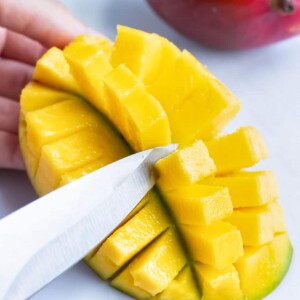
email this recipe!
Ingredients
- 1 mango
Instructions
Classic Method:
- Cutting the Cheeks: Place mango on a cutting board with the stem facing up. Insert a sharp knife about ¼-inch to the right of the midline. Starting from the top of the fruit, cut all of the way down to the bottom. Repeat this process with the left side of the mango. You should have 3 slices of mango at this point (2 cheeks and 1 midsection with the pit.)
- Dicing the Flesh: Using a smaller pairing knife, hold the mango in your non-dominant hand and make vertical incisions into the flesh of the mango. Pay careful attention not to cut all of the way through into the skin. Turn the mango 90 degrees and make vertical cuts that intersect the previous ones in a crosswise fashion. Repeat this step with the other mango cheek.
- Cut, peel, or spoon Flesh: You can remove the mango pieces by either using a paring knife, your thumb, or a spoon. Place your tool of choice where the flesh meets the skin and cut/push/scoop it off.
- Extra Mango around the Pit: There may still be some edible mango left around the pit. To get to this, place your paring knife into the skin of the midsection piece and carefully cut between the flesh and the skin to remove it.
Alternative Method (Vegetable Peeler)
- Peel Skin with a Vegetable Peeler: Using a vegetable peeler, remove all of the skin from the mango.
- Cutting the Cheeks: With the stem side facing up, remove the right and left cheeks from the mango as instructed above.
- Dicing the Flesh: Place mango cheeks flat-side down on a cutting board and dice or finely dice to your desired size.
- Extra Mango around the Pit: Remove any of the remaining edible flesh around the pit and dice to your desired size.
Tap stars to rate!
Video
Notes
Storage Directions
One medium-sized mango will yield 1 ¼ – 1 ½ cups of fruit. Follow the above directions to peel and cut your mango to prep ahead. To place freshly cut, diced, or sliced mango in an airtight container and store in the refrigerator for up to 2-3 days. To freeze, place cut fruit in a single layer on a baking sheet, cover with plastic wrap, and freeze for at least 4 or up to 24 hours. Place frozen mango pieces in a freezer-safe Ziploc bag and store them in the freezer for up to a year. Recipe Tips- Pick a ripe mango. A perfectly ripe mango will have a slight give and a fragrant aroma.
- Speed it up. Storing the mango in a paper bag at room temperature will cause it to ripen faster.
- Get cheeky. Cut the cheeks off parallel to the pit. You can tell which direction the pit is running by the shape of the mango.
- Use it all. Don’t forget the mango around the pit. There’s always a little extra fruit around the pit.
- Sweet and savory. This versatile fruit tastes great in everything from dinner to dessert!
Nutrition
Nutrition information is automatically calculated, so should only be used as an approximation.

